HIKING HAPPENINGS March 2010
Mill Creek Parkway–What a Winter!
by Marcy Hafner
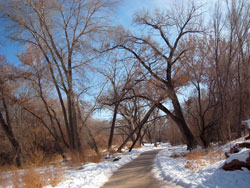 With so much snow and so much ice this winter where could a hiker possibly go? My solution to this dilemma has been the Mill Creek Parkway, which had been transformed into a whimsical winter wonderland of pure white snow: a wonderland where Mill Creek displayed her rare lovely face of smoothly sculpted crystal as she gurgled and flowed underneath thick layers of ice. Since the pathway was plowed, I didn’t have to stomp through inches of snow. Instead I could relax and enjoy an easy stroll with my feet firmly in place on dry pavement – ah the freedom of finally shedding my heavy gore-tex boots! With so much snow and so much ice this winter where could a hiker possibly go? My solution to this dilemma has been the Mill Creek Parkway, which had been transformed into a whimsical winter wonderland of pure white snow: a wonderland where Mill Creek displayed her rare lovely face of smoothly sculpted crystal as she gurgled and flowed underneath thick layers of ice. Since the pathway was plowed, I didn’t have to stomp through inches of snow. Instead I could relax and enjoy an easy stroll with my feet firmly in place on dry pavement – ah the freedom of finally shedding my heavy gore-tex boots!
The birthplace of Mill Creek is above Warner Lake in the La Sal Mountains, and from its high elevation origins it crashes down through Mill Creek Canyon to the very edge of town where it continues through the heart of Moab. Shortly thereafter her journey ends at the Colorado River.
On June 4, 1999, the Mill Creek Parkway was dedicated as a three-mile recreational pathway designed for non-motorized travel not far from the busy streets of town. Being able to access it at many different points, it can be handy for a quick stroll, jog or bicycle ride, eliminating the hassle of a winter drive while saving money on gas.
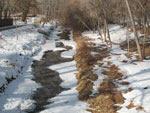 Since August 2004 the Mill Creek Friends of the Parkway have periodically removed trash from the path and creek and the recyclables are taken to Canyonlands Community Recycling Center. The Solutions, a volunteer group that emphasizes a “Respect, Rethink, Reduce, Reuse and Recycle” lifestyle, coordinates the program in partnership with the city of Moab. Since August 2004 the Mill Creek Friends of the Parkway have periodically removed trash from the path and creek and the recyclables are taken to Canyonlands Community Recycling Center. The Solutions, a volunteer group that emphasizes a “Respect, Rethink, Reduce, Reuse and Recycle” lifestyle, coordinates the program in partnership with the city of Moab.
The trail begins at Rotary Park, which is crammed full of kid-oriented activities. On a sunny day the air rings with the laughter of young ones playing on the swings, sliding boards and jungle gyms. They, and even the adults, can’t resist creating their own symphonies on the giant xylophones known as “free notes.” When that happens, haunting musical tones boom across the park.
To get to Rotary Park, turn east off Main Street on to Center Street (at the Moab Information Center.) Follow Center Street to 400 East and take a right. Continue on 400 East for five blocks and go left at Dave’s Corner Market on to Mill Creek Drive. Parking for Rotary Park is on the right hand side across from the Red Rock Elementary School.
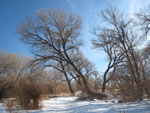 The bare branches of cottonwoods, hackberry, silver leaf poplars and catalpas along the path cast their barren image against a solemn blue sky as I leave the park. The striking plumage of a red-shafted flicker glistens in the sun as this woodpecker flies in an undulating rise-and-fall pattern from tree to tree. Listening to the chatter of magpies, ravens, crows and chickadees I almost forget how close I am to downtown. The bare branches of cottonwoods, hackberry, silver leaf poplars and catalpas along the path cast their barren image against a solemn blue sky as I leave the park. The striking plumage of a red-shafted flicker glistens in the sun as this woodpecker flies in an undulating rise-and-fall pattern from tree to tree. Listening to the chatter of magpies, ravens, crows and chickadees I almost forget how close I am to downtown.
It’s easier to observe the birds this time of year because the absence of foliage allows for better viewing, especially all those little guys who can no longer conceal themselves behind the thickness of leaves. The most abundant ground-feeding birds are the dark-eyed juncos, some masked with dark hoods. At any sudden movement these skittish sparrow-sized gray birds flit away with a flash of their outer white tail feathers to the safety of the brush. I like to think of them as our avian “snowbirds” that have retreated from a harsh winter elsewhere to a milder one in southeast Utah.
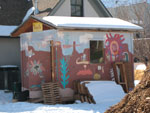 I pause to admire the colorful murals on the Youth Garden buildings located just beyond the imaginatively painted 400 East underpass. Within its two acres next to the high school, a wide variety of produce is organically grown and sold at the Farmer’s Market and local restaurants. Originally started in 1997 by the Juvenile Court system as a program for court-ordered community service, it has since expanded to become an outdoor educational program that offers lessons in science, garden-to-the table classes for elementary and middle school ages, a summer day camp and field trips. In 2007 twelve high school students built The Nibble Garden as part of their garden-science/natural resource management class, and during the growing season the public is invited to stop and nibble. I pause to admire the colorful murals on the Youth Garden buildings located just beyond the imaginatively painted 400 East underpass. Within its two acres next to the high school, a wide variety of produce is organically grown and sold at the Farmer’s Market and local restaurants. Originally started in 1997 by the Juvenile Court system as a program for court-ordered community service, it has since expanded to become an outdoor educational program that offers lessons in science, garden-to-the table classes for elementary and middle school ages, a summer day camp and field trips. In 2007 twelve high school students built The Nibble Garden as part of their garden-science/natural resource management class, and during the growing season the public is invited to stop and nibble.
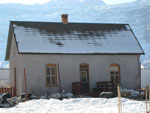 Adjacent to the Youth Garden is the historic Shafer House. Built in 1884 as the oldest home standing in Moab, it is officially listed in the National Register of Historic Places by the National Park Service. The original owner, John Henry Shafer, organized the local government of Moab and served as a Grand County Commissioner. In the early 1890’s he was named a school board trustee and became instrumental in getting the first schoolhouse started by lending the funds interest free. His obituary referred to him as “the Father of the Grand County school system.” The final owner was Richard Le Roy Holyoak. He and his wife Sarah lived on the property for thirty years and it became known as the Holyoak Farmstead. Adjacent to the Youth Garden is the historic Shafer House. Built in 1884 as the oldest home standing in Moab, it is officially listed in the National Register of Historic Places by the National Park Service. The original owner, John Henry Shafer, organized the local government of Moab and served as a Grand County Commissioner. In the early 1890’s he was named a school board trustee and became instrumental in getting the first schoolhouse started by lending the funds interest free. His obituary referred to him as “the Father of the Grand County school system.” The final owner was Richard Le Roy Holyoak. He and his wife Sarah lived on the property for thirty years and it became known as the Holyoak Farmstead.
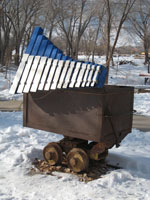 The Dan O’Laurie Museum has created an outdoor collection of antique mining and farming equipment along the parkway including the “early one-man mucker load haul dump,” a trackless diesel powered machine that was used up to the middle of the 20th century. A scrubber cleaned the exhaust gases and cooled any flames so it could be used underground without risk of igniting methane gas. The small shovel in the front mechanically loaded broken rock into the larger bucket. Then the operator drove it to an ore-pass where the full bucket was dumped. The Dan O’Laurie Museum has created an outdoor collection of antique mining and farming equipment along the parkway including the “early one-man mucker load haul dump,” a trackless diesel powered machine that was used up to the middle of the 20th century. A scrubber cleaned the exhaust gases and cooled any flames so it could be used underground without risk of igniting methane gas. The small shovel in the front mechanically loaded broken rock into the larger bucket. Then the operator drove it to an ore-pass where the full bucket was dumped.
Walking over the bridge just past Main Street, a short spur to the left leads to the Hospice Garden Memorial where the names of loved ones, who have died under Hospice Care, are carved on a white stone plaque. Continuing to the right the pathway now changes to dirt and the vegetation becomes a mixture of cottonwoods, tamarisk and Russian olive. This far down the trail where a small footbridge crosses the creek, the crowd has dwindled and the thick brush cuts out most signs of city life.
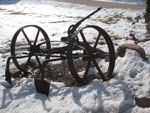 The final segment of the parkway is dedicated to Alvie Eugene and Ada Elizabeth Holyoak who in 1933 bought some land along Mill Creek – an 1887 homestead from the Wilson brothers. As cattle ranchers, the Holyoaks lived here until Alvie’s death in 1964. In the fall of 2002 the city bought 3.3 acres from their daughter Colleen and her husband D.L. Taylor, an acquisition that enabled the city to install the 500 west underpass so the parkway network could be extended. The final segment of the parkway is dedicated to Alvie Eugene and Ada Elizabeth Holyoak who in 1933 bought some land along Mill Creek – an 1887 homestead from the Wilson brothers. As cattle ranchers, the Holyoaks lived here until Alvie’s death in 1964. In the fall of 2002 the city bought 3.3 acres from their daughter Colleen and her husband D.L. Taylor, an acquisition that enabled the city to install the 500 west underpass so the parkway network could be extended.
The Mill Creek Parkway is a pleasant all season getaway that is so close to civilization and yet feels like an in-town country walk, which in the dead of winter can rescue you from a bad case of cabin fever. The promise of spring brings out the rollicking voices of birds and the fresh greenness of new growth. In the summer it is a delightful respite from the heat, which is followed by the golden glitter of the autumn foliage encouraging you to take a nostalgic fall walk.
|
Biological Soil Crust (aka)
Cryptos (krip’ tose):
The surface of
Moab’s desert is held
together by a thin skin of living organisms known as cryptobiotic
soil or cryptos. It has a lumpy black appearance, is very
fragile, and takes decades to heal when it has been damaged.
This soil is a critical part of the survival of the desert.
The cryptobiotic organisms help to stabilize the soil, hold
moisture, and provide protection for germination of the seeds
of other plants. Without it the dry areas of the west would
be much different. Although some disturbance is normal and
helps the soil to capture moisture, excessive disturbance
by hooves, bicycle tires and hiking boots has been shown
to destroy the cryptobiotic organisms and their contribution
to the soil. When you walk around Moab avoid crushing the
cryptos. Stay on trails, walk in washes, hop from stone to
stone. Whatever it takes, don’t crunch the cryptos
unless you absolutely have to! |
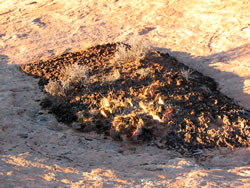
Cryptobiotic soil garden
|
|
|